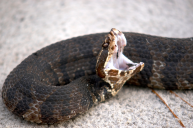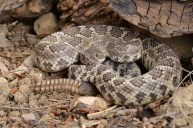If you've ever wanted to see rattlesnakes but were concerned about getting bit then you're in the right place. Check out this rattlesnake cam to see the snakes from the comfort of your own home without having the snakes in your own home.
Researchers at California Polytechnic State University in San Luis Obispo set up the live feeds. They want people to be less scared of the snake. Through Project RattleCam's two live streams, you can see inside the snake dens. One is located in California. Another is in Colorado. The video will be up until October.
In particular, the rattlesnake feed in northern Colorado captures a mega-den. Solar-powered cameras are capturing up to 2,000 snakes in the den. Researchers are using these feeds to learn more about the snakes. But they're also hopeful that it will make people less scared as well.
"This livestream allows us to collect data on wild rattlesnakes without disturbing them, facilitating unbiased scientific discovery," Emily Taylor, the project leader and a Cal Poly biological sciences professor, said in a news release on Monday. "But even more important is that members of the public can watch wild rattlesnakes behaving as they naturally do, helping to combat the biased imagery we see on television shows of rattling, defensive and stressed snakes interacting with people who are provoking them."
Rattlesnake Feed
The best time to watch the feeds is during the mornings or evenings. This is when the snakes are more active. Taylor described some of the things that she's seen.
"It has been amazing," Taylor said in a description of the Rattlecam project. "We watch the snakes drinking water off their backs, which is adorable. We've seen predators snatch up baby snakes. Magpies take babies and smash them against the rocks. It's a fascinating look at nature in action without the disruption of human proximity, which would affect how the snakes behave."
Meanwhile, you can see rattlesnake pups emerge in August. The cameras will be turned off for the winter.
"We hope to eventually install cameras on snake aggregations (group gathering) all over the world to help us better understand the behaviors of these complex, social animals," Taylor said.




